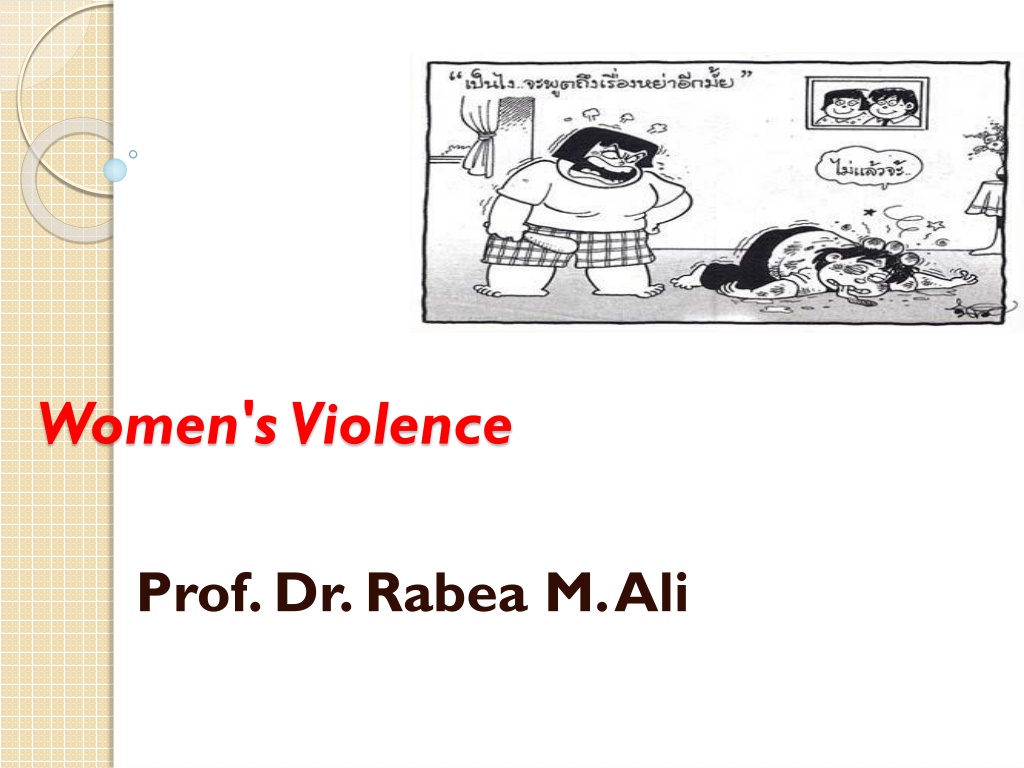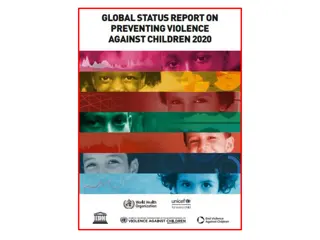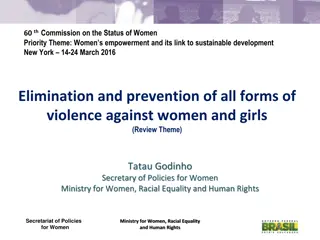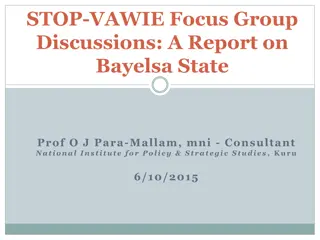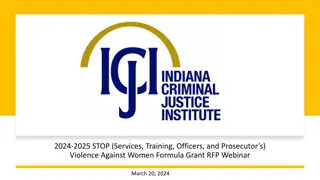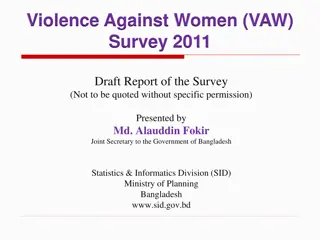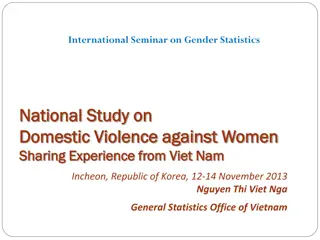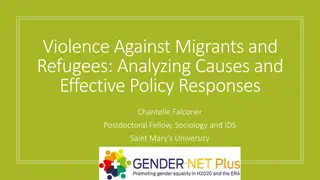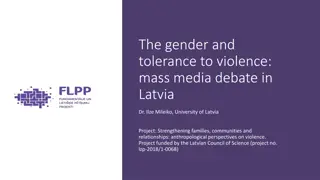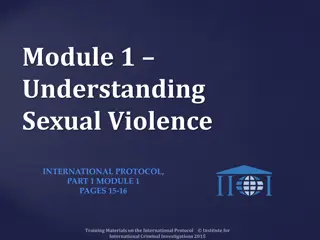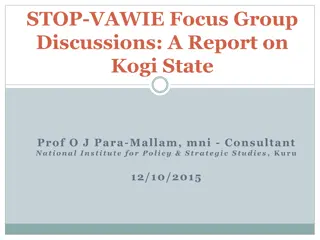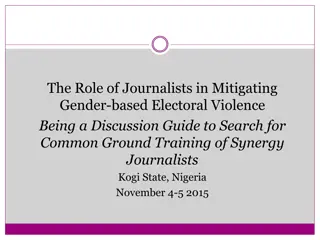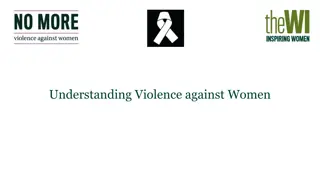Understanding Violence Against Women: Causes, Forms, and Impact
Violence against women encompasses various forms of physical, verbal, sexual, and controlling behaviors. Defined by the United Nations, it includes domestic violence and criminal acts like assault, imprisonment, and intimidation. Various forms of violence against women exist, from rape to honor killings and trafficking. Despite being common, victimization of women highlights societal issues like physical weakness, dependency, and social tolerance towards such acts.
Download Presentation

Please find below an Image/Link to download the presentation.
The content on the website is provided AS IS for your information and personal use only. It may not be sold, licensed, or shared on other websites without obtaining consent from the author. Download presentation by click this link. If you encounter any issues during the download, it is possible that the publisher has removed the file from their server.
E N D
Presentation Transcript
Women's Violence Prof. Dr. Rabea M. Ali
Womens Violence The United Nations defines violence against women as "any act of gender- based violence that results in, or is likely to result in, physical, sexual or mental harm or suffering to women, including threats of such acts, coercion or arbitrary deprivation of liberty, whether occurring in public or in private life."
abused3 WHAT IS DOMESTIC VIOLENCE Domestic violence is defined in the law as certain criminal acts committed between persons of opposite sex who live together in the same household or who have lived together in the past; or persons who have a child in common or are expecting a child (regardless of whether they have resided in the same household); or persons related to one another in the following ways: spouse(husband) , former spouse ,child, grandparent,, brother, grandchild, parent, sister
The criminal acts specifically defined in the law are: 1-Assault 2- Criminal damage 3- Custodial interference 4- Endangerment 5-Imprisonment 6- Intimidation 7- Kid-napping 8- Trespass 9- Disorderly conduct (by fighting, unreasonable noise, abuse language) 10- Reckless display or discharge of a deadly weapon or dangerous instrument
Types of Violence Physical: pushing, grabbing, slapping, kicking, biting or hitting with an object, suffocate use of knife or gun, acid throwing, burning. Verbal: shouting, making threats, calling names, humiliating remarks (gestures). Sexual: forcing intercourse, making her to do sexual things against her will. Exercising control: Isolating her from her family/ friends checking on her, using the children, economic control.
Various forms of Violence against Women Rape/Sexual Violence in Refugee camps Forced sexual initiation or abuse Sex-selective abortion honor killing (dowry related deaths) Undue virginity examination Forced caesarian section deliveries Trafficking in women and Girls
Victimization of Women so Common VIOLENCE Physically weak. Dependency status. Social tolerance of victimization. Little whom they associate with. Limited mobility
Effects of Domestic Violence Anxiety Chronic depression Chronic pain Death Dehydration Dissociative states Drug and alcohol dependence Eating disorders Emotional "over-reactions" to stimuli General emotional numbing Health problems Malnutrition
Panic attacks Poor adherence to medical recommendations Repeated self-injury Self neglect Sexual dysfunction Sleep disorders Somatization disorders Tension family relationships Suicide attempts Inability to adequately respond to the needs of their children
WHO response 1-Building the evidence base on the size and nature of violence against women in different settings and supporting countries' efforts to document and measure this violence and its consequences, including improving the methods for measuring violence against women. This is central to understanding the size and nature of the problem at a global level and to initiating action in countries. 2-Strengthening research and research capacity to assess interventions to address partner violence.
3-Undertaking interventions research to test and identify effective health sector interventions to address violence against women. 4-Developing technical guidance for evidence-based intimate partner and sexual violence prevention and for strengthening the health sector responses to such violence.
5-Generalization of information and supporting national efforts to advance women's health and rights and the prevention of and response to violence against women. 6-Supporting countries to strengthen the health sector response to violence against women. 7-Collaborating with international agencies and organizations to reduce and eliminate violence globally.
Intimate partner violence Refers to behavior by an intimate partner that causes physical, sexual or psychological harm, including physical aggression, sexual coercion, psychological abuse and controlling behaviors.
Sexual violence is "any sexual act, attempt to obtain a sexual act, or other act directed against a person s sexuality using coercion, by any person regardless of their relationship to the victim, in any setting. It includes rape, defined as the physically forced or otherwise coerced penetration of the vulva or anus with a penis, other body part or object."
Risk factors Factors associated with intimate partner and sexual violence occur at individual, family, community and wider society levels. Some factors are associated with being a criminal of violence, some are associated with experiencing violence and some are associated with both.
Risk factors for both intimate partner and sexual violence include: Lower levels of education (sexual violence and experience of sexual violence); Exposure to child maltreatment Witnessing family violence Antisocial personality disorder . Harmful use of alcohol . Having multiple partners or suspected by their partners of infidelity. Attitudes that are accepting of violence and gender inequality .
Factors specifically associated with intimate partner violence include: past history of violence; marital disagreement and dissatisfaction; difficulties in communicating between partners.
Factors specifically associated with sexual violence perpetration include: beliefs in family honor and sexual purity ideologies of male sexual entitlement weak legal sanctions for sexual violence.
Health consequence 1-Violence against women can have fatal outcomes like homicide or suicide. 2-Intimate partner violence and sexual violence can lead to unintended pregnancies, induced abortions, gynaecological sexually transmitted infections, including HIV. problems, and
3-Intimate partner violence in pregnancy also increases the miscarriage, stillbirth, pre-term delivery and low birth weight babies. 4-These forms of violence can lead to depression, post-traumatic stress and other anxiety disorders, sleep difficulties, eating disorders, and suicide attempts. likelihood of
5-Health effects can also include headaches, back pain, abdominal pain, fibromyalgia, gastrointestinal disorders, limited mobility and poor overall health. 6-Sexual violence, childhood, can lead to increased smoking, drug and alcohol misuse, and risky sexual behaviors in later life. It is also associated with perpetration of violence (for males) and being a victim of violence (for females). particularly during
Impact on children Children who grow up in families where there is violence may suffer a range of behavioral and emotional disturbances. These can also perpetrating or experiencing violence later in life. Intimate partner violence has also been associated with higher rates of infant and child mortality and diarrheal disease, malnutrition). be associated with morbidity (e.g.
References United Nations, 2014. Guidelines for Producing Statistics on Violence against Women Statistical Surveys. FRA (European Union Agency for Fundamental Rights), 2014. Violence against women: an EU wide survey.
Thank you abused3
